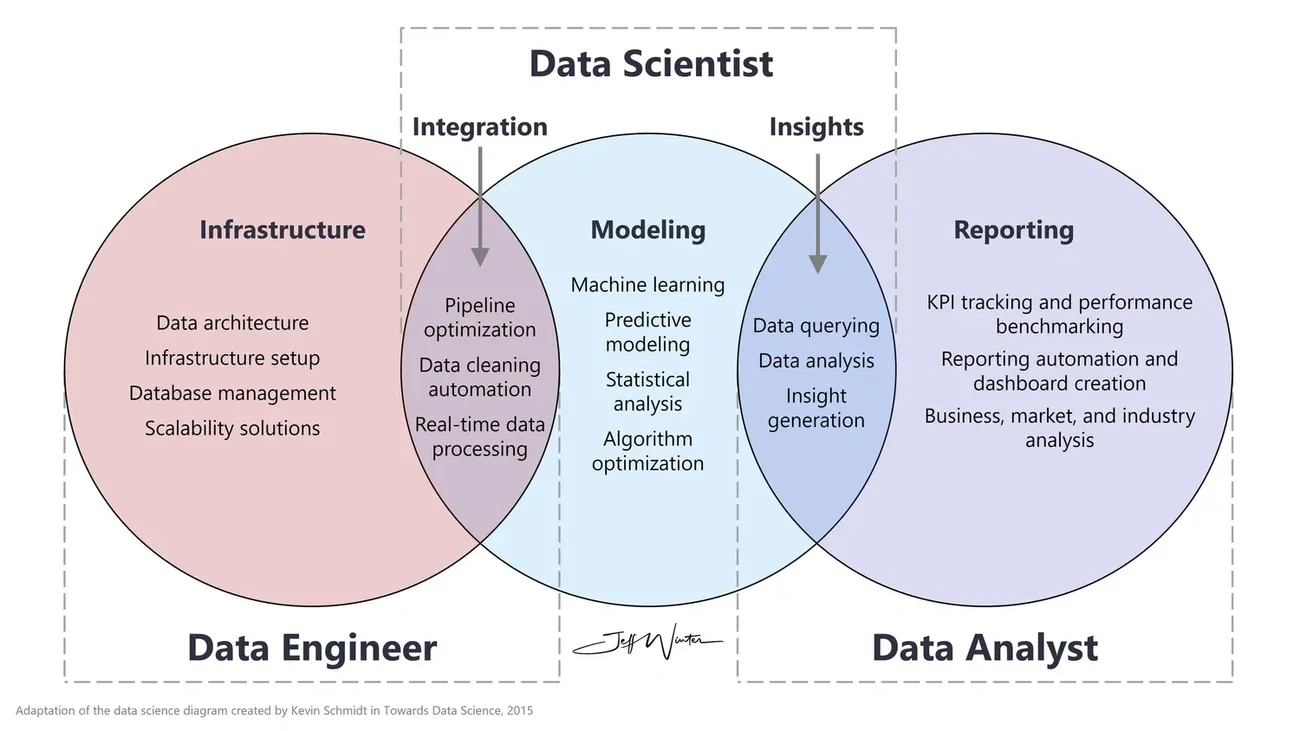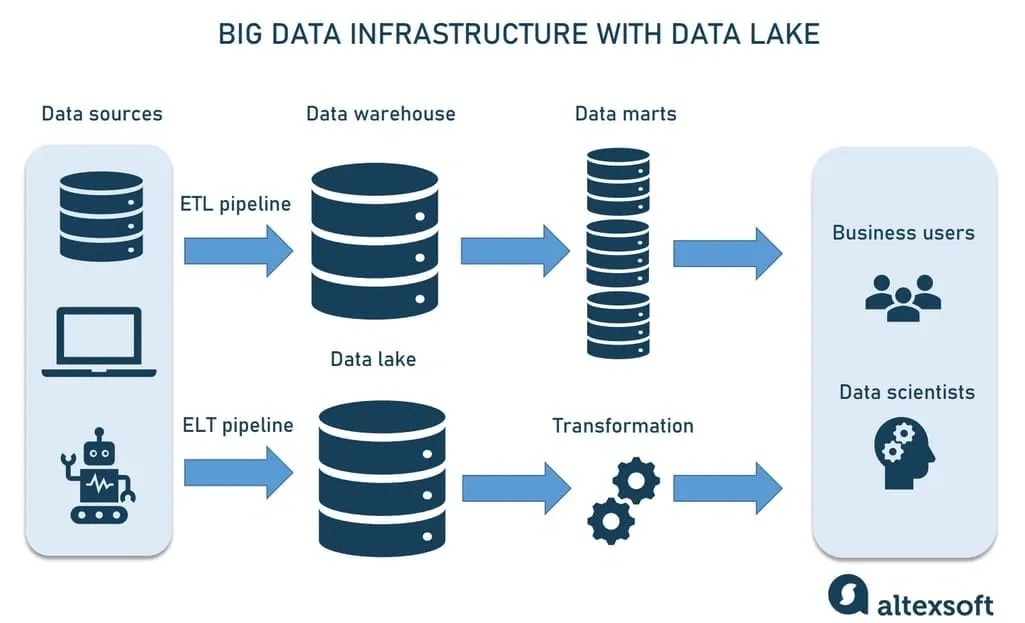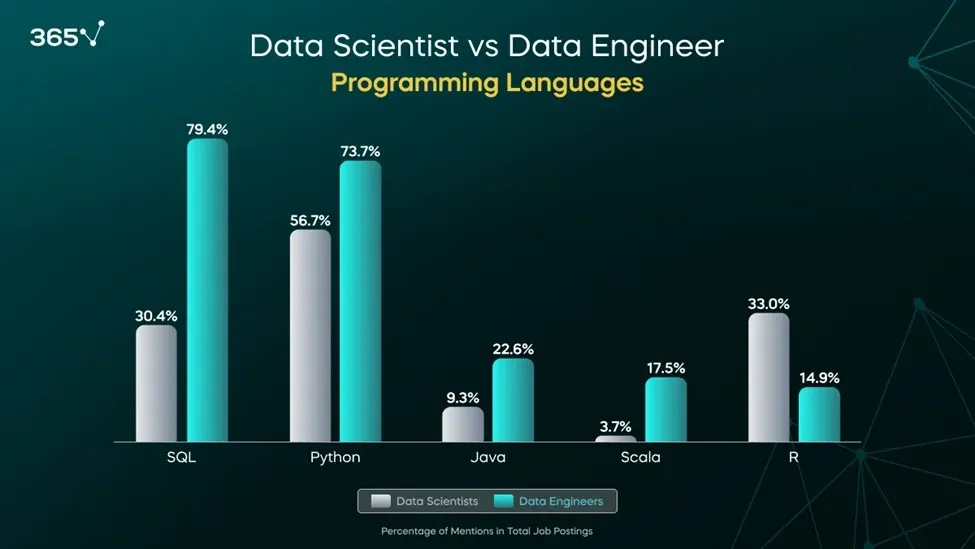Data Science vs Data Engineering: Why 87% of Students Choose Wrong!
The choice between data science and data engineering has become tougher as both careers promise great salaries and growth potential. Data scientists in the US make an average of $123,069 per year. Entry-level salaries typically range from $86,000 to $120,000, depending on location and company. The job market looks bright too. The U.S. Bureau of Labor Statistics expects data science roles to grow by 36% from 2023 to 2033. This growth will create about 20,800 job openings each year.
These roles might seem similar, but they need different skills and approaches. Your career goals matter a lot as you pick your path. Data engineers build reliable data architecture and create ETL pipelines. Data scientists use big data analytics tools to learn about patterns and build models. The US job market shows more than 10,000 data scientist and 5,000 data engineer positions on Indeed. Picking the wrong career path can leave you stuck and unhappy. This piece will help you see the main differences between these two in-demand data careers and help you pick the one that matches your strengths best.
Understanding the Core Roles

Image Source: Jeff Winter
The digital world has changed by a lot, which has created distinct yet connected professional roles. A clear understanding of these core positions helps explain the basic differences in the data science vs data engineering debate.
What is Data Engineering?
Data engineering builds and maintains the strong infrastructure needed to manage data properly. Data engineers design, construct, test, and maintain complete data architectures that include databases and large-scale processing systems. They build foundational systems to collect, store, and prepare data for analysis, which makes information available, reliable, and secure.
A data engineer’s responsibilities usually include:
- Creating and optimizing ETL pipelines that turn raw data into usable formats
- Building data pipeline architectures that allow quick data flow
- Making sure data stays high-quality, reliable, and available
- Setting up data governance and security policies
Data engineers act as the architects of an organization’s data ecosystem. They streamline data intake and storage throughout an enterprise to give data scientists the foundation they need for their analyzes.
What is Data Science?
Data science combines computer science, statistics, and domain expertise to extract meaningful insights from data. Data scientists analyze and interpret the data that engineers have prepared, unlike their engineering counterparts. They apply advanced analytical techniques, including statistical methods and machine learning, to find patterns and generate forward-looking insights.
Data scientists typically handle these tasks:
- Analyzing data to find patterns and relationships
- Building predictive models and machine learning algorithms
- Turning complex findings into practical business recommendations
- Showing insights through data visualization
Why the Confusion Between the Two?
The boundary between data scientists and data engineers often blurs. Several factors cause this confusion. “Data science” sometimes serves as an umbrella term that has data engineering as a subfield. Small organizations often require their data scientists to handle engineering tasks too.
Data scientists used to handle every aspect of the data pipeline in the past. Organizations now recognize the need for specialized roles as data collection and administration have grown more complex. Both positions work with data at different stages, engineers create infrastructure to handle data, while scientists use that data to learn about decision-making opportunities.
Responsibilities and Workflow Differences

Image Source: AltexSoft
Data engineers and data scientists have fundamental differences in how they approach data tasks. These differences go beyond simple job titles and shape their core work methods.
Data Pipeline vs Predictive Modeling
Data engineers build resilient pipelines that automate data movement through multiple stages. They create flexible, dependable infrastructure to collect and process data from multiple sources. Data scientists, on the other hand, focus on deriving applicable information through statistical analysis and predictive modeling. Their main goal involves creating models that can forecast future outcomes by analyzing historical patterns.
ETL Pipeline Design vs Data Analysis
ETL (Extract, Transform, Load) processes form the core of data engineering work. These processes ensure smooth data flow between systems. Engineers must design pipelines that handle edge cases and execute flawlessly because failures can severely affect production environments. Data scientists take a different approach by conducting exploratory analysis on prepared datasets. They typically work with static data snapshots rather than production-level streaming data.
Collaboration in the Data Lifecycle
Data initiatives succeed when engineers and scientists work together effectively. Engineers create the foundation by making data reliable and available, which enables scientists to exploit this groundwork for model development and analytical insights. Netflix demonstrates this partnership through their recommendation algorithms. Engineers construct resilient pipelines for real-time user data collection, while scientists analyze this data to develop individual-specific recommendation models. Successful teams overcome technical challenges like different tools and cultural barriers by implementing standardized platforms and maintaining clear communication channels.
Tools, Skills, and Technologies Compared

Image Source: 365 Data Science
Data professionals use different tech tools based on their roles and goals. These tools help us understand the key differences between data science and data engineering.
Programming Languages: Python, SQL, R, Scala
Both roles need programming languages, but with different focus areas. Data scientists make use of Python and R to analyze statistics. Python helps them work with data through libraries like Pandas. Data engineers prefer Python, Java, and Scala to build reliable data systems. SQL remains essential in both fields to manage and query databases.
Big Data Analytics Tools: Spark, Hadoop, Kafka
Spark handles huge datasets quickly with its distributed computing framework and works well with many programming languages. Hadoop stands out at batch processing that won’t fail, thanks to its distributed file system. Kafka handles live data streams and can process over 1 million messages per second. Data engineers often master these infrastructure tools to manage data at scale.
Visualization and Reporting: Tableau vs Airflow
Tableau helps data scientists create clear visuals that explain findings to business teams. Airflow helps data engineers automate ETL workflows and schedule data tasks. These tools show how each role focuses on either analysis or infrastructure.
Shared Tools and Overlapping Skills
The toolsets of both roles now overlap more than ever. Both need to understand databases, data structures, and Python programming. Cloud platforms like AWS and Azure have become common ground as companies move their data operations to flexible environments.
Career Path, Education, and Salary Outlook
Data careers offer different educational paths based on technical focus and analytical requirements.
Educational Backgrounds: CS vs Stats vs Engineering
Computer science degrees lead the way for data engineering roles at 38.8%. Software engineering and information systems backgrounds are also common. These programs help students become skilled at systems architecture and database management to build strong data infrastructure.
Data scientists often emerge from different academic paths – statistics (17.2%), applied mathematics (21.8%), or dedicated data science programs (47.4%). Their education focuses on statistical inference and experimental analysis. Many data scientists pursue higher education. Data science job postings show that 25% require a PhD, while engineering roles need this qualification in just 4% of cases.
Certifications and Online Bootcamps
Professional certifications serve as great alternatives to traditional degrees. Google Cloud’s Data Engineer certification helps professionals confirm their cloud competency. The program’s graduates report 85% higher confidence levels. IBM’s offerings include Data Engineering Professional and Data Warehouse Engineering certificates.
Choose the right path with confidence. Get personalized guidance on data science vs data engineering!
Salary Comparison: Entry to Senior Levels
New data engineers can expect $90,000-$110,000 yearly. This figure jumps to $150,000+ after 7 years. Senior engineers working in tech hubs earn around $160,000. Data scientists typically start between $86,000 – $120,000; senior/lead roles can reach $160,000 – $210,000+, with some principal roles exceeding $250,000 in top-tier companies.
Job Market Trends and Future Demand
Both fields show remarkable growth potential. Data scientist roles will grow 36% from 2023-2033. This growth creates 23,400 new positions each year. Reports show strong demand for data engineers, with double-digit annual growth in recent years, sometimes reported above 50% in specific markets. This makes data engineering one of today’s fastest-growing tech careers.
Comparison Table
| Aspect | Data Science | Data Engineering |
| Core Focus | Analysis and interpretation of data to derive insights | Building and maintaining data infrastructure |
| Key Responsibilities | – Analysis of data patterns – Development of predictive models – Creation of ML algorithms – Data visualization – Communication of insights |
– Creation of ETL pipelines – Architecture development – Quality assurance – Data governance implementation – Security management |
| Primary Educational Background | – Statistics (17.2%) – Applied Mathematics (21.8%) – Data Science Programs (47.4%) – 25% require PhD |
– Computer Science (38.8%) – Software Engineering – Information Systems – 4% require PhD |
| Main Tools & Technologies | – Python – R – SQL – Tableau |
– Python – Java – Scala – Spark – Hadoop – Kafka – Airflow |
| Entry-Level Salary | $86,000 – $141,000 | $90,000 – $110,000 |
| Senior-Level Salary | Up to $277,931 (Principal) | $150,000+ (7+ years experience) |
| Job Growth (2023-2033) | 36% growth | 50% year-over-year growth |
| Primary Focus Areas | – Statistical analysis – Machine learning – Predictive modeling – Data interpretation |
– Pipeline development – System architecture – Data storage – Infrastructure management |
Conclusion
Several key differences between data science and data engineering can help you choose your career path. Both fields come with great salaries and resilient job growth projections. They need different skill sets and ways of handling data. Data engineers create and maintain the infrastructure needed to manage data well. They focus on building ETL pipelines and making data accessible. Data scientists analyze this prepared data. They find patterns and generate insights using statistical methods and machine learning.
Your education might point you toward one of these paths. People with computer science and software engineering degrees often do well in data engineering roles. Those with statistics and mathematics backgrounds are a better match for data science positions. Both fields pay well. Entry-level data engineers earn $90,000-$110,000 while data scientists start between $86,000-$141,000.
These roles work best for different types of people. Data engineering suits those who love building systems and tackling complex architectural challenges. Data science attracts professionals who excel at finding meaning in information and sharing those insights to shape business decisions.
Choose the right path with confidence. Get personalized guidance on data science vs data engineering!
The job market needs both specialists. Data science positions are growing 36% through 2033. Data engineering roles are expanding even faster at 50% year-over-year. This growth shows how modern businesses rely more on analytical insights. It also explains why knowing the difference between these roles matters so much.
Take time to evaluate your strengths, interests, and career goals before deciding. While these paths may look similar at first, they differ by a lot in daily tasks and required expertise. Your choice should match your natural abilities and priorities. This approach leads to better job satisfaction and career growth. Remember, success in either field comes from finding a role that matches your professional passion.


![Is Cyber Security Hard Expert Guidance Makes It Easy [2025]](https://skylineacademic.com/wp-content/uploads/2025/10/is-cyber-security-hard-expert-guidance-makes-it-easy.png)
